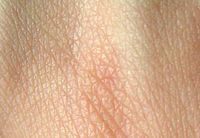
Photo from wikipedia
Intense research during the last few years has elucidated a number of mechanisms of the complex human aging process. Among the body organs, skin has a distinguished role in aging… Click to show full abstract
Intense research during the last few years has elucidated a number of mechanisms of the complex human aging process. Among the body organs, skin has a distinguished role in aging perception both because it constitutes the organ on which the first signs of aging are mostly visible and because skin is recognized as an indicator of human health. Analogous to all other organs, skin undergoes multiple morphological and functional changes with age affected by extrinsic and intrinsic factors. Evaluation of skin morphology as well as of advanced glycation end products, dermal collagen content and alterations of the Wnt signaling pathway may predict - among others - the aging status of the cardiovascular system, the brain and the bones. Increasing knowledge on the association of certain clinical and laboratory characteristics of extrinsic and intrinsic skin aging with organ-specific diseases opens new possibilities for the establishment of clinical and laboratory skin biomarkers for systemic human aging and the course of several internal, organ-specific diseases.
Journal Title: Mechanisms of Ageing and Development
Year Published: 2019
Link to full text (if available)
Share on Social Media: Sign Up to like & get
recommendations!